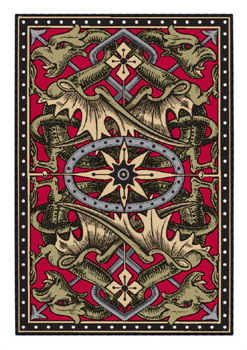Vintage Back Designs of
Bicycle
Playing Cards

Bicycle
playing cards are probably the most recognizable brand of
playing cards in the world. Although the average person probably
associates Bicycle brand playing cards with the famous "Rider Back" design, the United States
Playing Card
Company, or "USPCC" (which produces the Bicycle brand)
actually
produced over 80 different back designs with the "Bicycle" name over
the first few decades of the brand's existence. The Rider Back
design is
obviously the most familiar, having been in constant production
since
1887. But this was actually the second design to carry the
"Bicycle" name; the first was the Old Fan
back design, which was first produced in 1885 (and recently revived to commemorate the 125th
anniversary of
the Bicycle brand).
Bicycle
playing cards were originally produced in red, blue, green, and
brown, but the green and brown decks were discontinued in 1927.
The
reader may observe that many of the designs were revised one or
more times and thus appear in multiple variants (e.g. Racer
Back No. 1, Racer Back No. 2). This
usually happened for one of two key reasons. First, many of the
earliest
designs were "one-way" backs, i.e. the backs were asymmetrical. For
instance, several different backs contain a three-pronged wing in the
middle of
the card that can be oriented in 2 different ways. In the early
1900's,
most of these were revised to a four-pronged wing design to render the
backs
symmetrical. (The one notable exception is the League
back, which was first printed in 1893 and is the only back to retain a
three-pronged wing. It also appears that this back has never gone
out of
production, and is still a favorite among magicians because of its
asymmetry.) Second, the USPCC tried to keep up with the times, so
it
periodically updated the decks to reflect newer designs in bicycles,
automobiles, and motorcycles.
Indeed,
it was the attempt to be trendy that launched the Bicycle line
in the first place. According to company lore, in the early 1880's, cycling — on
unicycles,
bicycles, and tricycles — was taking the country by storm. It was
also
around this time that Russell & Morgan, the forerunners of the
United
States Playing Card Company, decided to produce a new line of cards and
asked
employees to suggest an attractive name for the new product. In
light of
the cycling craze, a printer, “Gus” Berens, offered the suggestion
“Bicycle.”
His idea was enthusiastically accepted, and the company has been
producing the Bicycle
brand of cards ever since.
In the
past decade, the USPCC has begun to capitalize on the Bicycle
brand's rich history, issuing a commemorative "Vintage
Design Series" in 2006 and a more limited "Heritage
Design Series" in 2010 and 2011, each of which featured re-printings of a
number of the old back designs. The Bicycle brand has also been
looking to the
future in recent years, partnering with magic companies and other
entities to
produce a number of new designs. Most of these were designed by
private
artists and produced in fairly limited quantities, often as essentially
private
label offerings for the magic companies (although still featuring the
Bicycle
brand name). The company has also issued
a few new Bicycle backs of its own design in recent years, perhaps most
notably
the Dragon back.
This
project is focused on the historical Bicycle back designs from the
first hundred years or so of Bicycle production, although I will
include at the
end a few of the more "modern" backs
currently
available.
For information on non-Bicycle back designs, please click here.
DISCLAIMER: This project
is presented for historical and educational purposes ONLY.
It is in large part a collection of
information available elsewhere on the internet. No
claim is made to original artwork produced
by the United States Playing Card Company or its predecessors, nor to
any
photographs thereof, which belong to their respective copyright
holders.
Table
of
Contents
3. Tournament Back, a.k.a.
"Pro Poker Peek"
Vintage Backs
1891-1943
(Red, blue, green, and brown.)
Reprinted in brown as part of theory11's Heritage Series
in 2012.




Introduced in 1907
(Red and blue.)
Reprinted by deckso in 2012.


Introduced in 1893, this is a scarce deck in any color. It is one of a few with no bicycles or bicycle parts featured in the design. (Red, blue, green, and brown.)

Introduced in 1906 (red/green, blue/brown)
In 2012, Dan and Dave offered a
similar back for sale under the "U.S. Regulation Playing Cards"
brand, in both in a "Striking Arizona Red" and a "Casual
California Blue."

Introduced in 1901. Initially called "Locomobile." (Red, blue, green, and brown.)

Introduced in 1904 (Red and blue.)


Introduced in 1913 (Red and blue.)


Introduced in 1902 (red and blue)


Introduced in 1906 (red and blue). There is apparently some debate over whether this back was actually ever printed.

1907-1917 (red and blue)


1901-1906 (Red, blue, green, and brown.)


1906-1919 (Red, blue, green, and brown.)


1906-1919 (Red, blue, green, and brown.)


Introduced in 1913. Discontinued in 1935. (red and
blue)
Reprinted in red as part of theory11's Heritage Series
in 2012.


Introduced in 1918. (Also
re-released in a limited run in 2010;
supposedly, there are plans to re-release the
other three World War I back designs in the future.)
This is one of the four extremely rare World War I back designs. They
were only
issued for one year and few complete decks are known to exist today.
The other
three designs are Dreadnaught, Flying Ace, and Invincible.
(Images are of the 2010 reprints.)


Introduced prior to 1891, likely discontinued within a year or two of its release. A very rare deck. (Red and blue.)

Introduced in 1908. Discontinued in 1910. This is a very rare deck, and one of three figural two-tone designs that appear to have been released solely in the United Kingdom. The other two are Handlebar and Saddle. (Red/green plaid and blue/brown plaid.)

Introduced in 1899. Discontinued in 1917. (Red and blue)
Also reproduced as part of the "Bicycle Heritage Design Series" in
2010.


Introduced in 1917. Discontinued in 1969. A long run for this design, but it must not have been very popular because you don't see too many Club decks around. (Red and blue.)


Introduced in 1906. Discontinued in 1911. A very rare deck. (Red/green and blue/brown)

1894-1943 (Red,
blue, green, and brown.)
Reprinted in 2006 as part of the "Vintage Design Series."
Also
reproduced c. 2010 in a limited custom run with gold trim by the ebay
seller ace-king-1
(aka John Aragi) and
featuring
the vintage Cupid Back design in gold on red/blue. Also reprinted as part of the 2011 edition of the "Heritage Design
Series."




Introduced in 1898. (Red and blue.)


Introduced in 1908 (Red and blue.)
This is one of the decks that was likely made for export only. Hard to
find in
any condition.

1914 (Red and blue)

1906 (Red and blue).

Introduced in 1918. (Red and blue.) This is one of the four extremely rare World War I back designs. They were only issued for one year and few complete decks are known to exist today. The other three designs are Big Gun, Flying Ace, and Invincible.

Introduced in 1928. (Red and blue)


Introduced in 1892. (Red, blue, green, and brown.) Also reprinted as part of the 2011 edition of the "Heritage Design Series."


Introduced in 1895. (Red and blue.) Similar to (and sometimes mistaken for) Old Fan Back. Indeed, on the 2010 release of the "Heritage Design Series" deck, USPCC itself misidentified on the package the Old Fan back as the Expert back.


Introduced in 1918. This is one of the four extremely rare World War I back designs. They were only issued for one year and few complete decks are known to exist today. The other three designs are Dreadnaught, Big Gun, and Invincible.

Introduced in 1908. Discontinued in 1910. This is a very rare deck, and one of three figural two-tone designs that appear to have been released solely in the United Kingdom. The other two are Chain and Saddle. (Red/green and blue/brown)


Introduced in 1918. This is one of the four extremely rare World War I back designs. They were only issued for one year and few complete decks are known to exist today. The other three designs are Big Gun, Dreadnaught, and Flying Ace. (Red and blue.)

Introduced in 1898. (Red and blue.)


Introduced in 1906. (Red and blue.)


Introduced in 1947.
This is one of a handful of decks sold under the Bicycle brand name
that
actually didn't depict anything even remotely resembling a bicycle on
it.
Another obvious one was the "Stag" back.
USPCC re-released the Leaf Back vintage deck in
July 2012 in red and green with the Christmas season in mind.


Introduced in 1893. (Also
reprinted on the "Rummy" decks produced in the early 2000's.)
Still being printed, although typically hard to find outside of a magic
shop or
specialty supplier. Unclear if they have
been in continuous production since 1893 or whether they are only
printed
periodically.
"These cards are sometimes referred to as Annemann long-distance
readers.
Presumably this is because the backs are one-ways. As
you've probably noticed, the three-pronged
wing in the middle of the card can be oriented in 2 different ways.
This deck
was first printed in 1893 and is the only back to retain a
three-pronged wing.
Other Bicycle brands that had three-pronged wing symbols changed over
to a
symmetrical four-pronged symbol in the early 1900s."


Introduced in 1891. (Red,
blue, green, and brown.)
One of the earliest Bicycle backs to have nothing remotely related
to
bicycles on it. Another back that came out the same year with no
bicycles or
bicycle parts depicted is the Bird back.
Reprinted in blue as part of theory11's Heritage Series
in 2012.


Introduced in 1910. (Red and blue.)

Introduced in 1893. (Red, blue, green, and brown.) Appears to have been the design used on the "Marlboro Texan No. 45 Poker Cards" produced in the 1980's as advertising decks for Marlboro. Also reprinted in January 2012 in red; intended primarily for the Asian market, distribution of this red reprint in the USA was limited. (The red version seen below is from the 2012 reprints.) It has also been reported that a black re-print will be issued in the fall of 2012.



Introduced in 1907.
(Red and blue.)

Introduced in 1912. (Red and blue.)

Introduced in 1912. (Red and blue.)

Introduced in 1901. (Red and blue.)


Introduced in 1906. (Red and blue.)


Introduced in 1913. (Red and blue.)

Introduced in 1895. (Red, blue, green, and brown.) Also reprinted as part of the 2011 edition of the "Heritage Design Series."



Introduced in 1907. (Red
and blue.)
Also used on "Euchre" decks in early 2000's, which referred to this
back design as the "Mountain Bike" back.


Introduced in 1901. (Red and blue.)

Introduced in 1907. (Red and blue.)

Introduced in 1906. (Red and blue.)


Introduced in 1901. (Red and blue.)


Introduced in 1914. (Red and blue.)


Introduced in 1901. (Red and blue.)


Introduced in 1907. (Red and blue.)


Introduced
in 1919. (Red, blue, green, and brown.)
Some would say that Nautic should not be listed as having
been issued
in green and brown. While that back design did come in those colors,
they were
not issued as Bicycle-branded decks and did not feature the distinctive
Bicycle
brand ace of spades and joker. Somewhat similar to the modern "Streamline"
brand, acquired by USPCC when it bought the Arrco Playing Card
Company in
the late 1980's and which it still sells today.
Reprinted in green as part of theory11's Heritage Series
in 2012.




Introduced
in 1894. (Red and blue.) Produced into the 1980's,
although I
do not know if it production was continuous throughout that time.
Reprinted in 2006 as part of the "Vintage
Design Series" as #2. Also reprinted as part of the two-deck
"Canasta" games series. And in 2011, a limited
run in black (5,000) and white (possibly only 1,000) was produced
by
magician Zennith Kok.


Introduced in 1885.
Discontinued in either 1894 (Hochman) or 1943 (see
USPC Heritage Series package). (Red, blue, green, and
brown.)
The very first back to be produced
under the "Bicycle" brand name (the second being the more
familiar "Rider" back, in 1887).
It was re-printed as part of the "125th
Anniversary Edition" decks produced in 2010.



1899-1917. (Red and
blue.)
Also reproduced as part of the "Bicycle Heritage Design Series" in
2010.


1894-1908. (Red and
blue.)
Also reproduced as part of the "Bicycle Heritage Design Series" in
2010.


Introduced in 1908. (Red and blue.)


1895-1906
(Red, blue, green, and brown.) Reprinted as part of the "Vintage
Design
Series" as #1. Also reprinted in the early 2000's as part
of the "games" series as Pinochle cards, with added
indices. Currently appears on the two-deck "Bicycle Euchre Set" games series.
What is commonly referred to by magicians as "Racers" is actually the
Racer No. 2 back. It was very similar to the Racer No. 1 except for the
wing
symbol in the center of the card. On the No. 1 it was a
three-pronged symbol that made the deck an obvious one-way back. When
the Racer
No. 2 came out in 1906 it had the four-pronged symbol shown here.




Introduced in 1906 (Red, blue, green, and
brown.)
What is commonly referred to by magicians as "Racers" is actually the
Racer No. 2 back. It was very similar to the Racer No. 1 except for the
wing
symbol in the center of the card. On the No. 1 it was a three-pronged
symbol
that made the deck an obvious one-way back. When the Racer No. 2 came
out in
1906 it had the four-pronged symbol shown here. Both the No. 1 and No.
2 Racer
backs were originally available in red, blue, green and brown. Produced through at least 1949.



1887-Present (Red,
blue, green, and brown.)
The back design is probably the most recognizable in the world, having
been in
constant production since 1887. They were originally produced in red,
blue,
green, and brown, but the green and brown decks were dropped in 1927. This was the second design produced under the
"Bicycle" name, the first being the Old Fan backs produced in 1885.




Introduced in 1908. Discontinued in 1910. (Red/green, blue/brown.)
This is a very rare deck, and one of three figural two-tone designs
that appear
to have been released solely in the United Kingdom. The other two are
Chain and
Handlebar.


1892-1943 (Red,
blue, green, and brown.)
Reprinted as part of the "Vintage
Design
Series" as #3. Also reprinted as part of the 2011 edition of the "Heritage Design
Series."



Introduced in 1904. (Red and blue.)

Introduced in 1899. (Red and blue.)


Introduced
in 1905. Discontinued in 1917. (Red and blue.)
(There is also an extremely rare assymmetrical variant, purported to be
an
early design attempt that was later replaced.
Issued in 1904.)


Introduced
in 1927. (Red and blue.)
Unclear why this back design was sold under the Bicycle brand name,
since it
actually didn't depict anything even remotely resembling a bicycle on
it. Another obvious example is the "Leaf" back.


Introduced
in 1906. (Red and blue.)

Introduced
in 1907. (Red and blue.)

Introduced
in 1895. (Red and blue.)


Introduced
in 1907. Discontinued in 1939. (Red and blue.)
First design to use the four-winged version of the American Wheelmen
emblem.
(Also reprinted as part of the "Vintage
Design Series" as #7. Currently appears on the "Bicycle Rummy Set" two-deck game set.)


Introduced in 1891. Discontinued in 1939. (Red and blue.) Features elves that were taken from designs used by the New York Consolidated Company, which merged with The United States Playing Card Company in 1894. (Also reprinted as part of the "Vintage Design Series" as #6)


Introduced in 1905. (Red and blue.)

Introduced in 1898. (Red and blue.)


1905-1927
(Red
and blue.)
Also reproduced as part of the "Bicycle
Heritage Design
Series" in 2010.


Introduced in 1907. First called Coral in 1904. (Red and blue.)

Introduced in 1914. (Red and blue.)

Introduced in 1887. (Red, blue, green, and brown.)




Introduced in 1907. (Red, blue, green, and brown.) Also reprinted as part of the games series as the "Solitaire" decks (the tuck-boxes of which refer to this design as the "High-Wheel" back). This back design is virtually identical to the Wheel No. 1 except that the Wheel No. 1 had a three-pronged wing symbol. This was changed along with many of the other backs that contained a three-pronged symbol in or around 1907. The only three-pronged back to survive without this change seems to be the League back.


This design is probably the rarest of all Bicycle decks -- so rare that it was not included in Mrs. Robinson's 1955 exhaustive catalogue of Bicycle cards. Only a couple of full decks are known to exist.
.

Selected Modern Backs
As noted in the
introduction, USPCC has been making a number of "custom" decks for
customers in recent years under the Bicycle name. Typically, these decks
are designed by the customer or its independent artist, and these custom-run
designs are owned by the customer, not USPCC; USPCC is simply the manufacturer.
In some cases, individual artists have
been able to get their decks printed directly from USPCC by
"crowd-source" funding for their unique concept decks through the
"Kickstarter" website.
USPCC
has also been offering
a number of color variations on the Rider back (e.g. pastels,
inverted color scheme, eco-"green" and breast cancer pink backs), sometimes also with
minor
changes to the court cards or faces. I have not chosen to include
any of
those many color variants on the basic rider back.
But in
some cases, USPCC is
still expanding the Bicycle offerings with its own designs (i.e.
designs which
it actually owns). Here is a selection
of some of these more recent (relatively speaking) back designs.
1994
(Red and green). A holiday twist on
the
traditional Rider back. Even included a
joker with a bagful of goodies on his back.
Came in a two-card set in a holiday tin.
1995
(Red and green.) Another holiday twist on
the traditional Rider back. Came in a two-card set in a
holiday tin. Apparently much more rare
than the Holiday back (above), because prices on eBay routinely exceed
that
back by a factor of 5 or more.


3. Tournament Back, a.k.a. "Pro Poker Peek"
Introduced
in 2007.
A "special version" of the famous Rider back design, inspired
by the custom card back design used at the World Series of Poker beginning in
2007. Developed especially for Texas Hold 'Em, faces feature the
"PokerPeek" face style, which consists of (1) an angled corner pip,
allowing the poker player to peek at any corner and know the cards in his hand,
and (2) jumbo index style center marks, making them more visible when laid on the
table. Decks also featured the
"ProCut" edge, with a barely-visible bevel that allows better gripping
during shuffling. Printed on custom
casino paper which is "slightly heavier than traditional Bicycle cards,
and provides a premium feel."
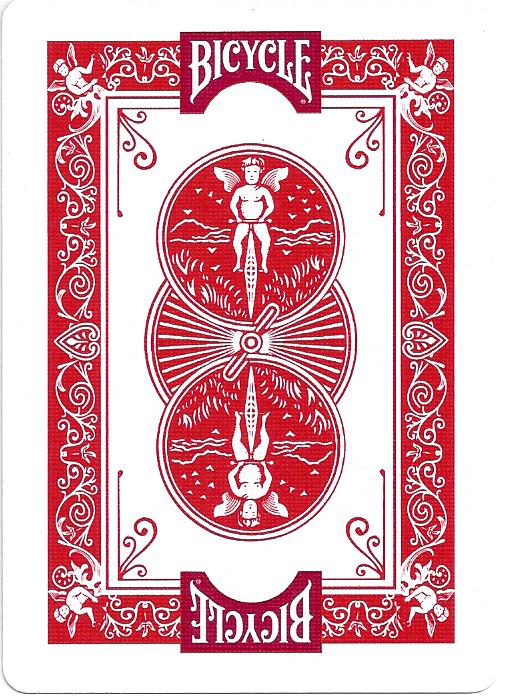
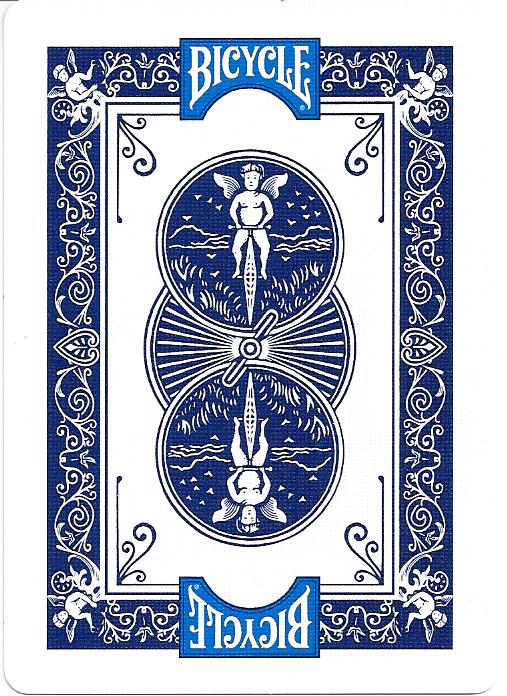
Introduced
c. 2008. Designed by and produced in
connection with magic supply house theory11.com.
However, it is included as part of the regular Bicycle catalog and sold in
some retail
stores. According to theory11.com, "This is what the classic Bicycle
Angels look like on steroids."
Notably, on the tuck box, USPCC claims rights only in the
Bicycle name
and logos, and not any of the design elements of the deck.
For the 2008 U.S.
Presidential Election, USPCC
released a three-deck series: "Democrat," "Republican," and
"Independent," featuring a donkey, an elephant, and an eagle,
respectively. (The backs and jokers of
each set featured the respective animal.)
The royalty cards featured variations on George Washington
(kings),
Betsy Ross (queens), and Abraham Lincoln (jacks). Pictured
below are the backs for the Democrat
and Republican decks and the tuck box for the Independent deck; I am
still
trying to locate a suitable photo for the Independent deck back.



Introduced
in 2008. The deck was the first of a supposed
series of 10 Limited Edition playing card decks introduced to appeal to
collectors and players; however, USPCC is reported to have discontinued the series after only producing the first two designs.
Back is a simpler, cleaner version of the traditional Rider Back
in
black and white. The jokers were redesigned specifically for this
series.


Introduced
in 2009. This
deck was the second of a supposed
series of 10 Limited Edition playing card decks introduced to appeal to
collectors and players; however, USPCC is reported to have discontinued
the series after only producing the first two designs. The jokers were redesigned specifically for
this series.
Introduced in 2009. These all-plastic cards were manufactured in
Spain. The center of the design features
the familiar "rider angel" from the Rider Back design, but the back
is otherwise a different design from the standard Rider Back. Not part of the "808" series, the
milestone on the joker is lacking the "808" designation.
Otherwise, the faces of the cards are the
standard Bicycle faces.
Introduced 2010.
(Red and blue.)
Similar to the Rider back, but featuring an angel
holding a mandolin in place of the angel riding the bicycle. Also
noteworthy at the stock number for these on the box (as well as the Ace of
Spades and joker) is "809," instead of the more familiar Bicycle
"808." This deck was intentionally designed to resemble the
Rider back; USPCC no longer allows changes to their standard Rider back
design, so this back design is used so magicians can create gaff cards to use
in their magic routines and not have the audience think it is a special deck.
USPC brought in magician Paul Harris to work with
a world class team of artists (including Garrett Thomas) to develop the new
back. Produced by USPC and intended for the magic community, the
deck is primarily distributed through Murphy's Magic
Supplies, Inc. Despite this limited distribution model, USPCC owns
the rights to this deck.
Introduced 2010
(red) and 2011 (blue, gold).
This design was supposedly "discovered" recently by an employee
searching through in the USPCC archives. The Dragon Back was
designed
decades ago, possibly in the early 20th century, but there is no record
of it
ever having been produced. Distributed nationally through Target stores and elsewhere. Although production was originally intended to be limited, sales have
apparently been quite good, and it appears to have become a regular
offering. (I have seen decks of the red with both 2010
and 2011 copyright dates on the tuck-boxes, which suggests to me that they have
had more than one production run.)
It is also worth noting that this back is a subtle one-way design (i.e.
asymmetrical), as the mouths of the dragons are not identical.
Introduced in 2011. Designed by USPCC. Features
sword fighting stick men on the
non-pip indices that appear animated when the deck is riffled. Back design also consists of many little
stick figures.
A robot-themed Bicycle deck. Available in both black and blue. Released in late 2011 or early 2012.
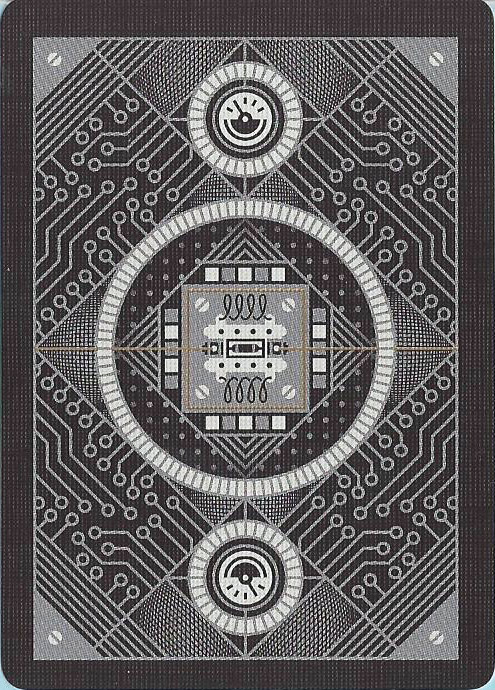
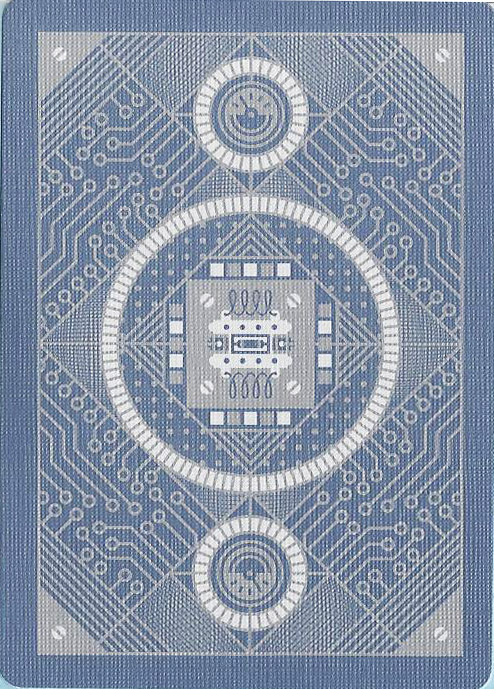
Released in 2012, this deck is available in a metallic
copper, a metallic silver, and a "regular" tannish-colored tuck box. Those in the silver-colored box have a
slightly different color back.
"Steampunk" is a sub-genre of science fiction, fantasy, or alternate history
involving a setting where steam power is still widely used; in essence, it imagines what the world would
look like if technological innovations of the nuclear-powered 20th century had instead
happened in the steam-powered Victorian Era.
(For more information, see here or here.)
The original and copper colors were a collaboration between USPCC and theory11 (designed by Alex Beltechi), while the silver deck was a USPCC-only release (June/July 2012). This deck should not be confused with the steampunk-themed "Actuators" deck privately produced by artist Lance T. Miller.
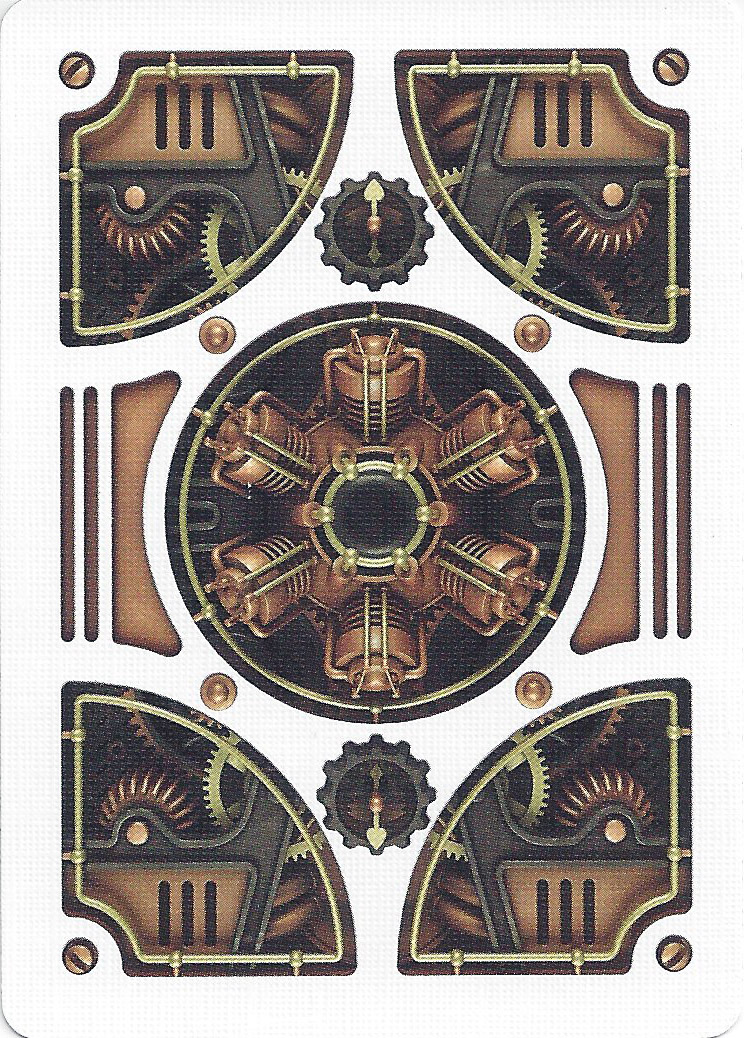
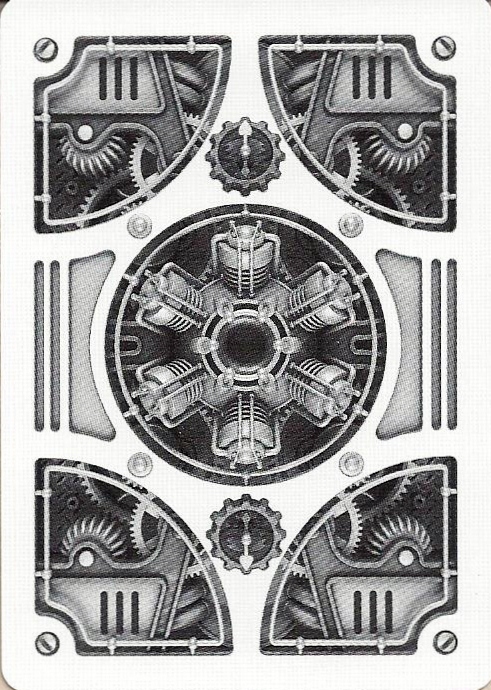
Introduced 2012.
(Red and blue.)
Similar to the Mandolin back concept, which
was to create for magicians a deck that looked like the Rider
back, but which USPCC would permit to be altered. Closely resembles the Rider back, but features a maiden in flowing garb
in place of the angel riding the bicycle. Supposedly, the stock
number for these is "813," instead of the more familiar Bicycle
"808" (although the milestone on the joker still reads "808," so it is unclear if this is actually the case.) Produced by USPC and intended for the magic community, the deck is
primarily distributed through Houdini's
Magic Shop Despite this limited distribution model, USPCC owns the
rights to this deck. Despite this
limited distribution model, USPCC owns the rights to this deck.
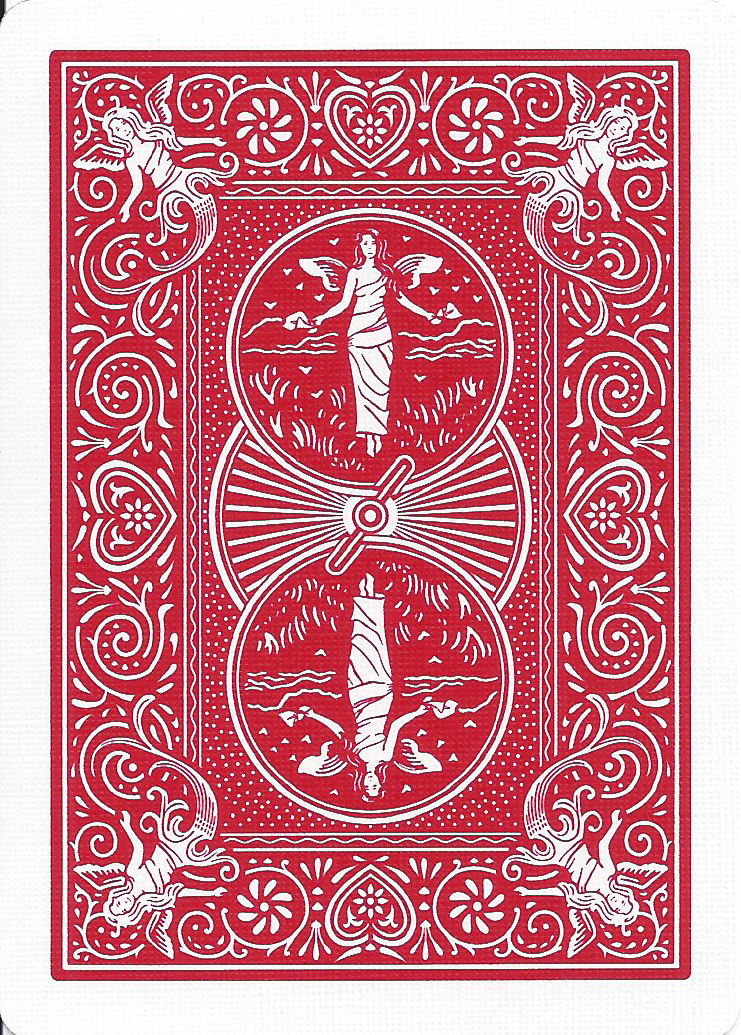
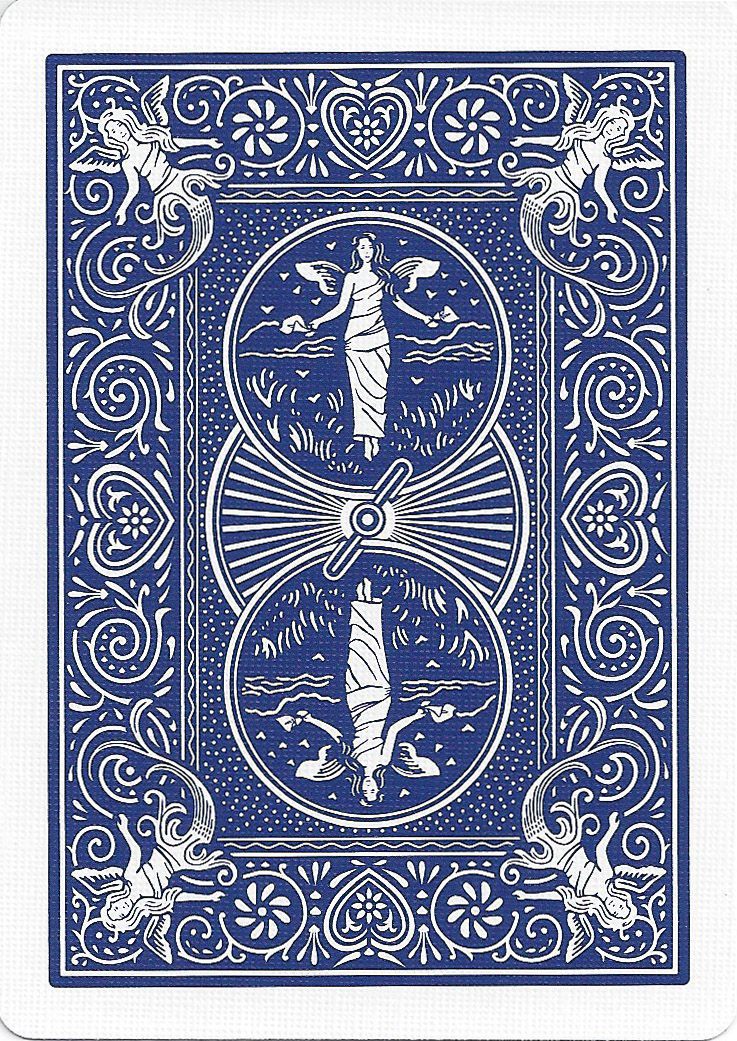
This deck features buff-colored cards with standard Bicycle faces. The ace of spades and jokers include hemp leaves, and the court cards are brightly colored, especially with hues of red and green. Seems like a pretty obvious appeal to the "pot" crowd, although the promotional materials (of course) pay tribute to the " sustainability, durability, and varied usage of hemp fibers."
This off-the-wall deck features original artwork on the front and back of the cards, including zombified face cards and jokers. Each card also features survival tips in case of zombie attacks. Puns abound ("These decks were reanimated in the USA" and feature a "scare-cushion finish").
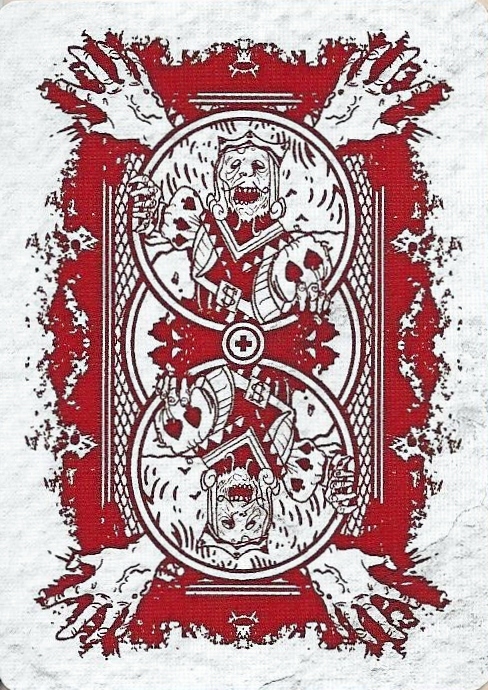
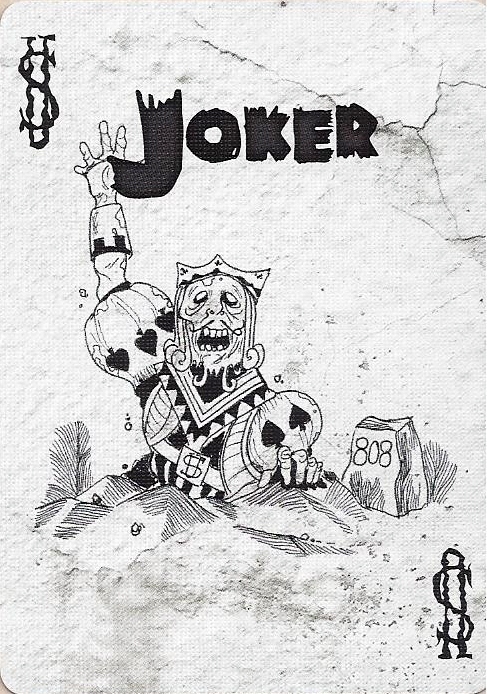
Miscellaneous
As
noted previously, the USPCC has made a practice in recent years of
issuing its
Rider back in a variety of different colors; it is far more likely to
do this
to customize a deck than to actually design a new back.
Here is a selection of but a few of those
color variations.






References
and Resources:
- Mrs. Joe Robinson: Playing Card Collector's Handbook, Description and List,
Bicycle Brand Playing Cards, 1955. Available
for viewing at: http://www.cypressfilms.com/Bicycle//Robinson/Robinson.html
- Dawson, Tom & Judy: The Hochman Encyclopedia of American Playing Cards, U.S.
Games Systems Inc., 2000
- Hargrave, Catherine Perry:
A History of Playing Cards and a Bibliography of Cards
and Gaming, Dover Publications, New York, 1966
- The World of Playing
Cards, http://www.wopc.co.uk/usa/uspcc/bicycle-808.html
- http://www.cypressfilms.com/bicycle/index.html
(Color photos and information)
- http://web.archive.org/web/20061110072226/http://www.nls.physics.ucsb.edu/~nathanb/cards/newpictureindex.html
(Color photos and information)
- Playing Cards Wiki, http://playingcards.wikidot.com/
- Bicycle Playing Cards, http://www.bicyclecards.com/about/bicycle-cards
- International Directory of Company
Histories,
http://www.enotes.com/company-histories/united-states-playing-card-company - Bicycle
Canada/International Playing Card Company, Ltd.
http://www.bicyclecards.ca/game-rules/playing-card-history/32.php?page_id=32 - http://www.bicycle-cards.co.uk/history-of-cards/
- Official Bicycle Cards
Facebook page, Note, https://www.facebook.com/note.php?note_id=163437777017129
- http://809bicycle.com/
- USPC Bicycle 809 Mandolin
Back Deck: Frequently Asked Questions,
Revised October 1, 2010
http://www.murphysmagicsupplies.com/additional_files/MANDOLIN%20DECK%20FAQ.pdf - http://www.unitedcardists.net/uc/forum/viewtopic.php?f=5&t=3788&start=20
- http://www.unitedcardists.net/uc/forum/viewtopic.php?f=5&t=1922&p=24983&hilit=dragon+back#p24983
- http://cgi.ebay.com/2-DECKS-Bicycle-Dragon-Back-playing-cards-/300483285702?pt=LH_DefaultDomain_0&hash=item45f63312c6
- theory11, http://www.theory11.com/playingcards/guardians.php
- The United States Playing
Card Company 2011 Product Catalog, http://www.bicyclecards.com/catalogs/USPC_OnlineCatalog_Playing_Cards_1-7.pdf
- Thomas L. McDonald's State
of Play blog,
http://www.stateofplayblog.com/2010/09/bicycle-rider-backs-808.html (photo) - World Web Playing Card Museum, http://www.a.trionfi.eu/WWPCM/decks06/d04331/d04331box808.htm (photos)
- Gambling Incorporated, http://www.gamblingincorporated.com/product.php?productid=16240
- BMPokerWorld blog, http://blog.bmpokerworld.com/2012/05/bicycle-maiden-back-playing-cards.html
- Lee Asher, http://www.leeasher.com/playground/articles/how_to_date_a_deck_of_cards.html
- The United States Playing Card Company 2012 Product Catalog, http://www.bicyclecards.com/catalogs/USPC_OnlineCatalog_R25.pdf
- 52 Problems: A Playing Card Collector's Reference,
https://sites.google.com/site/cardconjurer/












